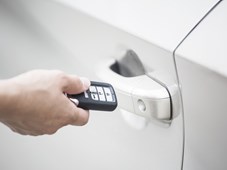The Modern Car Key Fob is More Sophisticated Than You Think
By Eric Grange | September 10, 2018

Much is expected of the modern car key fob. It should be small enough to fit comfortably in a pocket, its buttons should give a reassuring “click” when pressed and, most importantly, it should open the car door when required – especially in the airport long-stay car park in the pouring rain. Above all else, the key fob needs to operate reliably when used, often several times a day over the life of the car, for up to several years. Along the way the device is likely to suffer no small amount of abuse – being thrown around, soaked in the rain, or maybe even going through the washing machine!
All this means that switches for key fobs require some specific characteristics. Generally speaking, they need to provide a good tactile feeling for a clear acknowledgement of the opening or closing of the vehicle’s doors. Bearing in mind that protecting and sealing the mechanics of the switch will affects its behaviour, a decisive, snapping effect is an important feature.
An important consideration with any device designed to be handled is its size, and the space required for each element. Space constraints are increasing, not because the fob is becoming smaller, but due to the increased number of functions, and therefore buttons. So space can be limited, and this is why small tactile switches are necessary. Consumer electronics these days offer a variety of tactile switches at small sizes. However, automotive requirements are much stricter than consumer electronics, and having the right level of performance is crucial – which tends to exclude “basic” switches from this application.
Many key fobs have a form factor that follows the credit card format; here the main constraint is height, as the system must be as flat as possible, necessitating very low-profile switches.
Perhaps the most important aspect of the key fob is its robustness. Ensuring the reliability of such a well-handled device requires consideration of all the possible failure modes, under harsh conditions as well as through simple ageing. This, in turn, demands improved switch characteristics.
With this in mind, C&K has introduced three tactile switch series dedicated to key fob application:
- RKA – a low-profile switch for applications where height is a consideration
- RKB – for applications where robustness is needed
- RKC – for applications where space is limited
All series target a high actuating force to give the best possible tactile performance.
Key fobs also need to cope with increasing levels of car connectivity. It’s true that smartphones can interact with the vehicle for various applications (such as temperature setting, or user identification when car sharing); however, the key fob remains a proven and safe way to lock and unlock the vehicle. Some key fobs now incorporate displays, which requires a drastic change of architecture. The major impact on switches is moving them from the top to the side of the unit. Side actuation switches are now required for this new arrangement, again with the necessary levels of robustness and reliability. Here integration, tolerance management and resistance to shear are critical. The C&K KSS series is a perfect product for this type of application.
Conclusion
In summary, there’s a great deal of functionality packed into the modern car key fob. Much of the intelligence and electronics of the RKS system benefits from IoT technology, but the switches, which represent the key user interface, bear the brunt of the potentially harsh environmental conditions and are expected to perform day in, day out.
With a 30-year track record in the industry, C&K embodies the core values of automotive switching, and its products, such as the RKX range of tactile switches, are ideal for remote keyless systems.

Eric Grange
Global Segment Manager
Automotive
